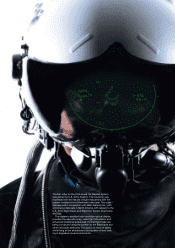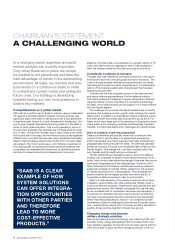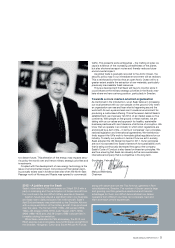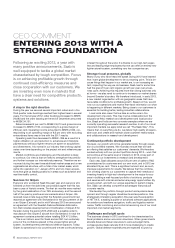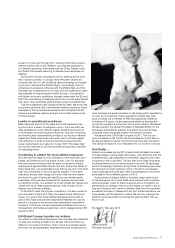Saab 2012 Annual Report Download - page 17
Download and view the complete annual report
Please find page 17 of the 2012 Saab annual report below. You can navigate through the pages in the report by either clicking on the pages listed below, or by using the keyword search tool below to find specific information within the annual report.
SAAB ANNUAL REPORT 2012 13
Increased need to safeguard
supply chains and make them
more efficient
Society is becoming an increasingly
integrated network society, with expand-
ing cross-border ows of capital, energy,
goods and people. The trend towards a
global ow economy has increased the
functional and security needs of the civil/
commercial sector. It is in the interest of
the international community and the major
economies to maintain critical ows.
Impact and our position:
As integration between countries, econo-
mies and infrastructure systems increases,
there is greater demand for efciency and
security.
Saab has progressively strengthened
our position within surveillance, particu-
larly within trafc management with the
acquisition of Sensis and HITT. There is
also clear development potential in the
surveillance of other civil functions. Read
more on pages 18 and 20–21.
Technology development
Increasingly advanced information and
communication technology (ICT) under-
pins essentially all dimensions of society,
which have become more vulnerable as
a result. Advanced ICT is also of greater
importance in more and more weapon
systems and major investments are being
made in cyber security.
Technology development is also ad-
vancing rapidly in the area of unmanned
aerial systems.
Impact and our position:
ICT is an important driver behind the inte-
gration of military and commercial technol-
ogy, where there is a growing overlap,
especially in surveillance and control.
System integration is our core compe-
tence, which is largely a matter of integrat-
ing ICT for applications with many different
functions. Read more on pages 8–9 and
14–15.
Sustainable solutions – in several
dimensions
Access to energy is a critical factor in the
development of living standards, national
competitiveness and the ability to maintain
critical societal functions, and is therefore
central to both military and civil strategies.
There is a wide-spread aspiration to be-
come less dependent on undesireable, po-
litically sensitive sources and to capitalise
on the economic benets of new technol-
ogy. Another dimension is the need to
reduce global environmental and climate
risks and provide support when natural
disasters occur. Development and security
go hand in hand in this area as well.
Impact and our position:
Providing systems and solutions that
safeguard important energy sources is
essential for a safe society and a growing
market. There is also growing interest in
developing solutions with better energy
performance to reduce impact on the
climate and environment. This affects both
the focus of Saab’s development projects
and the need to run the business in a
sustainable manner.
Read more about our sustainability
work and development projects on pages
32–43.
WING OF THE FUTURE DEVELOPED IN LINKÖPING
A brand new integrated technology to build composite wings can reduce fuel consumption
by ve to eight per cent. By curing the shell surface together with stringers and ribs, the inner
structures of the wing can be secured entirely without rivets on the exterior. This reduces turbu-
lent ow over the wing and provides the desired fuel savings. Weight is also reduced, which also
helps to lower fuel consumption.
This development is being conducted within the framework of the Smart
Fixed Wing Aircraft project, which is part of the EU’s Clean Sky initiative.
The collaboration demonstrates Saab’s design and production capabilities
and reinforces Saab’s role as an important subcontractor.
A major challenge is to scale up this technology and deliver a full-scale
wing while meeting the very aggressive schedule. In early 2015, Airbus will
test an Airbus A340 with Saab’s 9x3 metre wing component to evaluate the
technology. This is one of the main deliverables of the Clean Sky project.
also
reduced
,
which
a
lso
ar
t
e
s
e
wil
l
t
he
.


